

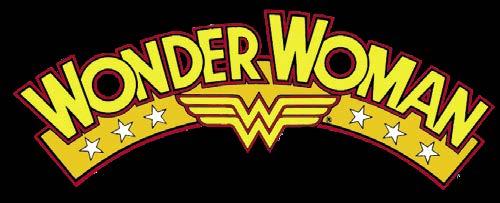
No.147 October 2023 $10.95 Wonder Woman TM & © DC Comics. All Rights Reserved. the 20 th ANNIVERSARY EDITION OF… ™ THE GEORGE PÉREZ YEARS GEORGE PÉREZ’s 20 GREATEST HITS OF THE BACK ISSUE ERA PLUS SPECIAL FEATURES 1 8 2 6 5 8 0 0 5 1 2 2
October 2023
EDITOR-IN-CHIEF
Michael Eury
PUBLISHER
John Morrow
DESIGNER
Rich Fowlks
COVER ARTIST
George Pérez
(Originally produced in 1990 and published in 2006 in the trade paperback Wonder
Woman vol. 4: Destiny
Calling. Art scan courtesy of Heritage Auctions.)
COVER COLORIST
Glenn Whitmore
COVER DESIGNER
Michael Kronenberg
PROOFREADER
David Baldy
SPECIAL THANKS
Nick Barrucci
Jarrod Buttery
DC Comics
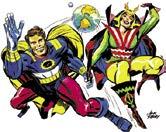
Shelton Drum
Jim Ford
Glenn Greenberg
George Gustines
Tom Heintjes
Ilke Hincer
Heritage Auctions
Heroes Aren’t
Hard to Find
Dan Johnson
James Heath Lantz
Christopher Lawrence
Dave Lemieux
Steve Lipsky
Tony Lorenz
Ed Lute
Ralph Macchio
Heidi MacDonald
Andy Mangels
Karla Marsh
George Pérez Tribute Issue
Brian Martin
Robert Menzies
Ian Millsted
Doug Moench
Mindy Newell
Eric NolenWeathington/ Modern Masters
Joseph Norton
Luigi Novi
Patrick Daniel O’Neill
Tom Powers
Jason Roe
San Diego Comic-

Con International
Tom Sciacca
Jason Shayer
Jerry Smith
Steve Trevor
Mark Waid
Steven Wilber
Marv Wolfman
Doug Zawisza
Eddy Zeno
Don’t STEAL our Digital Editions!
BACK ISSUE™ issue 147, October 2023 (ISSN 1932-6904) is published monthly (except Jan., March, May, and Nov.) by TwoMorrows Publishing, 10407 Bedfordtown Drive, Raleigh, NC 27614, USA. Phone: (919) 449-0344. Periodicals postage paid at Raleigh, NC. POSTMASTER: Send address changes to Back Issue, c/o TwoMorrows, 10407 Bedfordtown Drive, Raleigh, NC 27614
Michael Eury, Editor-in-Chief. John Morrow, Publisher. Editorial Office: BACK ISSUE, c/o Michael Eury, Editorin-Chief, 112 Fairmount Way, New Bern, NC 28562. Email: euryman@gmail.com. Eight-issue subscriptions: $97 Economy US, $147 International, $39 Digital. Please send subscription orders and funds to TwoMorrows, NOT to the editorial office. Cover artwork by George Pérez. Wonder Woman TM & © DC Comics. All Rights Reserved. All editorial matter © 2023 TwoMorrows and Michael Eury. Printed in China. FIRST PRINTING
Volume 1, Number 147
C’mon citizen, DO THE RIGHT THING! A Mom & Pop publisher like us needs every sale just to survive! DON’T DOWNLOAD OR READ ILLEGAL COPIES ONLINE! Buy affordable, legal downloads only at www.twomorrows.com or through our Apple and Google Apps! & DON’T SHARE THEM WITH FRIENDS OR POST THEM ONLINE. Help us keep producing great publications like this one!
IN MEMORIAM: George Pérez by Marv Wolfman 2 FLASHBACK: My Friend, George Pérez by Tom Sciacca . . . . . . . . . . . . . . . . . . . . . . . 4 ART GALLERY: Young George Pérez . . . . . . . . . . . . . . . . . . . . . . . . . . . . . . . . . . . . . . 8 GEORGE PÉREZ’s 20 GREATEST HITS OF THE BACK ISSUE ERA . . . . . . . . . . . . . . . . . 11 ART GALLERY: Pérez Rarities . . . . . . . . . . . . . . . . . . . . . . . . . . . . . . . . . . . . . . . . . . 54 BACKSTAGE PASS: Wonder Woman by George Pérez 59 INTERVIEW: Mindy Newell and Wonder Woman #46 . . . . . . . . . . . . . . . . . . . . . . . . 77
TALK: Reader Reactions . . . . . . . . . . . . . . . . . . . . . . . . . . . . . . . . . . . . . . . . . 79
BACK
George Pérez Tribute Issue • BACK ISSUE • 1
2010 George Pérez original art to the cover of the TPB Crisis on Multiple Earths vol. 5. Courtesy of Heritage. TM & © DC Comics.
The 20th Anniversary Edition of
Friendship is a strange thing. It could go on for a lifetime, or it could be fleeting, temporary. Sometimes if you have not seen a friend for years, a reunion seems like no time has passed. And if the friend is no longer on this plane of existence, the friendship lasts forever.
When I heard that George Pérez had passed away on May 6, 2022, my heart stopped. I was not just a fan of his, but had been a friend, best buds, for over 50 years. I was his first fan.
It was September 1968. I had just started high school— Cardinal Hayes Memorial High School, on the Grand Concourse, in the South Bronx. I had two classmates from St. Lucy’s, Frank Vignali and John Norris. Otherwise, it was all me. Here was a school with 3,000 students. Early on, I fell for the pool pass scam, buying from a senior a pass for a non-existent pool. I was pretty naive.
When I first read about the school, I learned they had an art program. When I got there, the program had been cancelled. I was upset—What now? I blew it! Shoulda gone to Art and Design. Then someone told me about the Poster Club, which met after class. This was a club where the aspiring artist could use his skill on posters to be displayed about the school, “exciting” things like basketball games, baseball games, football games… Hayes was a jock school. Artists were nerds.
So I walked into the classroom. A priest was the supervisor. We had art supplies, left over from the now-dead art classes.
There was a tall, dark-haired fellow there, another freshman. He was talkative, and started mentioning comic books. His name was George Pérez.
We hit it off immediately. I was the only other guy there that George had met who dug comic books.
Let me digress for a moment. Hayes was an ALL-BOYS SCHOOL. Lots of testosterone. No females, except for a nun here or there. So both of us not being sports guys, George and I bonded immediately.
George and I were in different homerooms. When we got together, it was at lunch. Hayes had a huge cafeteria, where we got in line military-style to get the food from the kitchen ladies. Usual Catholic School prison food: Salisbury steaks, corned beef hash, mac and cheese—like I said… prison food.
It was in the cafe that George and I got together for our art sessions. Our tools: Flair pens, pencils, and 8x10 art paper pads bought from Woolworth’s (the Dollar Tree of that time).
George and I would draw our favorite heroes. I was strictly Marvel—Captain America, Fantastic Four. But George was a DC guy—Superman, Teen Titans, Justice League—an omen of things to come.
We often brought in comic books to use as reference, or to trade. There was a secondhand store on 149th Street and Third Avenue that we would walk to after school—we would get used comics there for five cents each! I scored an Amazing Spider-Man #1 there for a nickel—a beat-up copy, but hey!
One day, I brought in a book to lend George. I had been active in fandom for a few years, buying fanzines like Bill Wilson’s The Collector and Marty Greim’s The Comic Crusader. I dug the articles, and particularly the fan art and the fan comic strips, like Marty’s The Defender. But the one I liked the best was Star Studded Comics. I had discovered this zine from a review in the late, lamented Castle of Frankenstein magazine.
The first issue I obtained, from Larry Hearndon, Buddy Saunders, and the Texas Trio was #9. It had a fantastic Dr. Weird cover with a demon threatening a scantily clad woman on a bed, with Dr. Weird in the background appearing in a puff of smoke. Interior art was by Alan Weiss, whom I would get to know years later at DC Comics.
Battle On, Battalion!
Courtesy of Steve Lipsky, the cover to the unpublished fanzine Battalion #2 (1970), featuring pencils, inks, and colors by a young George Pérez. George and his school chum Tom Sciacca created the characters, which were also seen in Battalion #1—the only copy of which was destroyed by the dreaded “Dean of Discipline”!

4 • BACK ISSUE • George Pérez Tribute Issue
© Tom Sciacca and George Pérez.
by Tom Sciacca
1977 pencil selfportrait . Previously published on page 16 of the 1977 book, George Pérez, Accent on the First E . Courtesy of Steve Lipsky

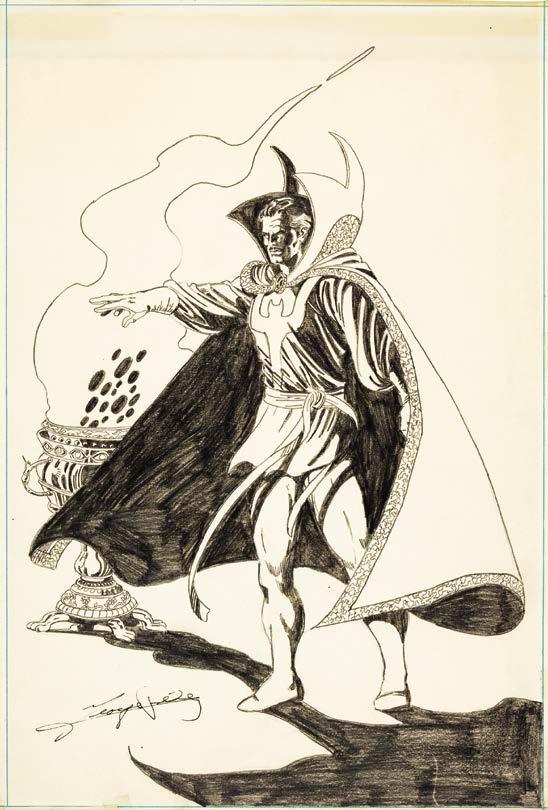


8 • BACK ISSUE • George Pérez Tribute Issue
(left) George’s 1973 take on the amazing Spider-Man, from the portfolio he was shopping around at Marvel and DC at the time . Courtesy of Steve Lipsky . (right) An undated early Pérez portrait of Dr . Strange . Courtesy of Heritage Auctions (www.ha.com)
Spider-Man and Dr. Strange TM & © Marvel.
George Pérez possessed the uncanny talent of taking almost any comic book he drew and turning it into something special—even during the infancy of his career. And thus, some might suggest it is a fool’s errand to limit a list of Pérez’s “greatest hits” to only 20.
Yet, this being the 20th anniversary edition of BACK ISSUE, ye ed and our pool of talented freelance writers, via a poll conducted among our merry group, have chosen 20 Pérez-drawn comic books from the Bronze Age that, for a variety of reasons, rise
above the pack. Your mileage may vary, but from our perspective, these issues are milestones. In some cases, they reflect career achievements for George as an artist. In others, their stories—deftly detailed by the pacesetting penciler—introduce important new characters or storylines with lasting resonance.
And in all cases, they represent the extraordinary craftsmanship and the buoyant enthusiasm of the artistry of the late, and sorely missed, George Pérez.

George Pérez Tribute Issue • BACK ISSUE • 11
Comic: The Inhumans #1 (Oct . 1975)
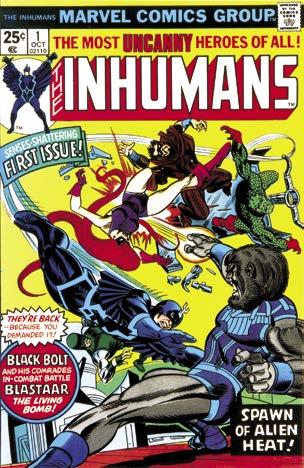
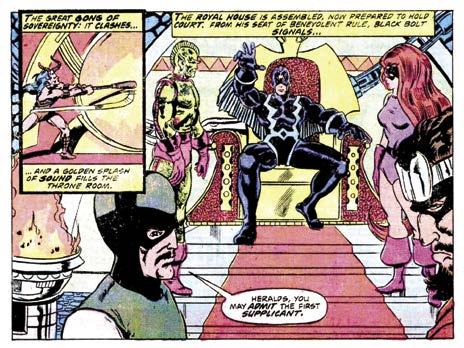
Publisher: Marvel Comics
Cover art: Gil Kane and Frank Giacoia
Title: “Spawn of Alien Heat”
Writer: Doug Moench
Artists: George Pérez and Frank Chiaramonte
The Inhumans #1 (Oct. 1975) is the type of Marvel mid-1970s work that is quintessentially emblematic of that decade of comic-book storytelling with its fast-paced narrative and wildly imaginative ideas. In other words, who would have thought that the Inhumans would become the stars of their own book and then get soundly trounced by another Fantastic Four (i.e., Stan Lee and Jack Kirby) creation, Negative Zone villain Blastarr, by the end of their first issue alone?! Notably, this FF spinoff also marks the first number-one issue for George Pérez , years before such landmark books as The New Teen Titans #1 (Nov. 1980), Crisis on Infinite Earths #1 (Apr. 1985), and Wonder Woman #1 (Feb. 1987).
Paired with writer Doug Moench, George was filled with youthful vigor and ambition as he penciled the first issue of this series. Wanting to know more about this collaboration, I called Doug and asked him about how he and George were assigned The Inhumans by Marvel. Moench tells BACK ISSUE , “George had the reputation, and that was more than a reputation—it was the truth—that he was the best guy for any comic that had 30 crazy characters in it: The Avengers , The Inhumans , Justice League, anything like that.

12 • BACK ISSUE • George Pérez Tribute Issue
No. 1
TM & © Marvel.
I think he requested The Inhumans . He loved doing that. I don’t know why, since it would have driven me insane if I were an artist. I remember that we were friendly in the Bullpen, and we’d talk, and I’d say, ‘We got to work together,’ but he was into costumes and superheroes, and I was not really, as I was the writer for Master of Kung Fu and the horror stuff.”
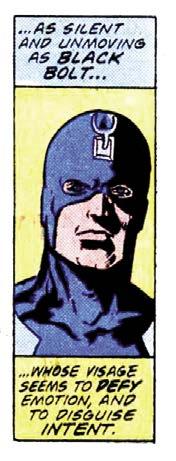
Upon hearing this, I immediately wondered how Doug managed to team up with George to depict the new solo adventures of Black Bolt, Medusa, Triton, Karnak, and Gorgon. “Finally, I got onto a book that was kind of like superheroes but not really superheroes,” Moench explains. “Yet the Inhumans always struck me as mythology, gods or something, and George loved these characters, and he was supposed to do the book as long as I was on it, which was one of the reasons I agreed to do it, saying, ‘Oh, George will draw it. Oh, okay.’ Then, George found out—as usual, this was a constant thing with him—that his eyes were bigger than his stomach, and he had already committed to whatever books he was doing, The Avengers or Fantastic Four maybe. But he had to do The Inhumans, and then I found out he couldn’t do the book, but he did a great job on that first issue.”
When describing what he particularly admired about George’s pencils on The Inhumans #1, Doug says, “I appreciated the fact that he could get so many characters into a panel, and they still



looked pretty good. I also thought George’s storytelling on that issue was good, as he did architecture and backgrounds. He was willing to draw small and put a lot of panels per page in the issue, which is another thing many artists cannot do. They all want to draw big pinups, or they did back then.” On this note of George’s intricate storytelling ability, I brought up page 10 of The Inhumans #1, which depicts an old woman, Iridia, submitting herself to the Inhumans’ Terrigen Mist in a desperate gamble to rid herself of what she calls her lifelong ugliness, which he relayed with an impressive 17 panels. “Yeah, I know,” Doug laughs. “He was a workaholic, and physical limitations didn’t seem to enter into his mind. He just wanted to do it so bad, and I remember saying to him, ‘George, we do have to sleep a few hours per night, you know.’”
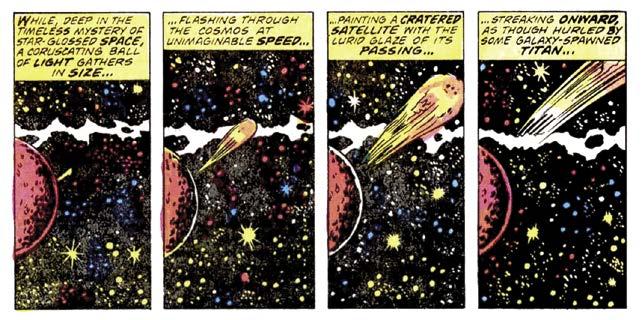
With his final comments regarding his friend and collaborator, Doug touchingly reflects, “I think George was such a sweet guy. He was so hardworking and always tried to do the best possible job. And he loved what he was doing, and you could tell. As I said, I didn’t like doing superhero books, but I remember being quite happy when George turned in his first batch of pages for The Inhumans #1, and I was like, ‘Oh, man, I’m going to have fun doing this.’”
Tom Powers
George Pérez Tribute Issue • BACK ISSUE • 13
From the book George Pérez, Accent on the First E, a 1977 Logan’s Run montage originally published by the Omnibus Publishing Company . George penciled the adaptation of the nowclassic sci-fi film for the first five issues of Marvel’s Logan’s Run comic book . Courtesy of Dave Lemieux . Logan’s Run © MGM.
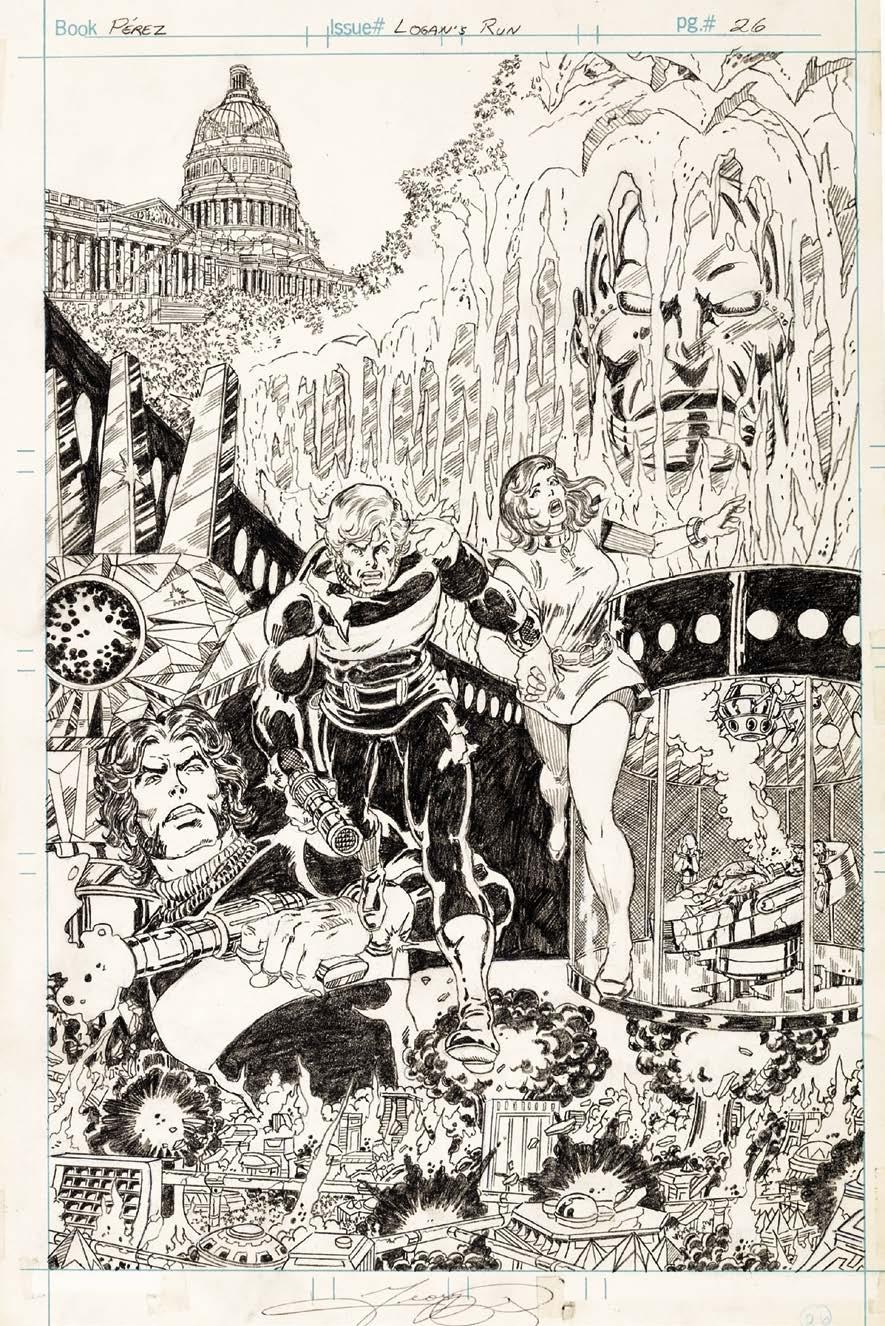
54 • BACK ISSUE • George Pérez Tribute Issue
George Pérez’s An Oral History
TM
by Andy Mangels
It is hard to separate the strands of my career over the last four decades from the career of George Pérez. He was 12 years older than me, and I first saw his work at Marvel, on the cover of Fantastic Four #184 (July 1977), with the heroes fallen in a pile of rubble. I was ten, and it was the first time that I began looking at who an artist was in the comics I got. Intense attraction to Pérez’s artwork led me, over the next seven years, to attempt to collect anything by him, and/or about him. When New Teen Titans #1 came out in November 1980, even Superman could not have held me back. Not only was my idol drawing the book, but it was a revamping of my favorite childhood team! In 1984, I decided it was time to finally meet George, and did so at the San Diego Comic-Con. I was 17, and he was polite and friendly to this young fanboy. The following year I contributed my first published work to Fantagraphics’ Focus on George Pérez book (Aug. 1985), and soon after was writing for Amazing Heroes magazine, sharing space with writers Mark Waid (now a comics luminary) and Michael Eury (the editor of this very magazine).
As often as I was allowed to, I covered Pérez in the press, which, it turned out, was often. In addition to his success on New Teen Titans, he worked with writer Marv Wolfman on the universe-shattering Crisis on Infinite Earths maxiseries. That 1985–1986 series redefined and streamlined DC’s multiverses, killing or erasing from existence many long-term heroes, and radically revamping others. One of the heroes “erased” was Wonder Woman, who was the most famous superheroine in the world, having enjoyed a near unbroken line of publishing since her debut in All Star Comics #8 (Dec. 1941), before headlining her own series, Sensation Comics #1 (Jan. 1942) and Wonder Woman #1 (June 1942). Wonder Woman had long been seen as a feminist icon, appearing on the front cover of Ms. Magazine #1 (July 1972) and in a popular live-action television series on ABC and CBS from 1975–1979, where her star-spangled tights were admirably filled
Strength and Beauty
Wonder Woman breaks free in this art from History of the DC Universe #2 (Feb. 1987), with pencils by George Pérez, inks by Karl Kesel, and colors by Tom Ziuko.

TM & © DC Comics.

George Pérez Tribute Issue • BACK ISSUE • 59
by actress Lynda Carter [see BACK ISSUE #5—ed.]. But Wonder Woman’s comic-book adventures by the 1980s had lost much of their sales, and DC Comics decided that something must be done. Thus, in Crisis on Infinite Earths #12 (Mar. 1986), Wonder Woman dissolved into the magical clay from which she had been sculpted by her mother.
DC was planning a revamp of Superman —which would be taken on by fan-favorite Marvel creator John Byrne—and a new version of Wonder Woman began to be developed, by writer Greg Potter and editor Janice Race. Eventually, George Pérez was brought onboard to draw, then co-plot, then co-write, then write and draw the second series to bear the title of Wonder Woman . The series debuted in February 1987, and Pérez stayed with it (though only as writer from #25 forward) until issue #62 (Feb. 1992).
During his time on the book, Pérez significantly played up mythological aspects of the series, established a broad supporting cast that was mostly female, and created some timeless stories for the “Amazing Amazon” that are referenced not only by every creator who has worked on Wonder Woman since, but also by the Warner Bros. animation projects and the two Wonder Woman feature films.
Rather than just give a history lesson in the remembrance of Pérez’s Wonder Woman, I decided to structure this as an Oral History, interweaving quotes from not only my extensive interviews with George, but also (with permission) from others who had interviewed George over the decades since. In this manner, you’ll be able to revisit some of George’s thoughts as he was creating the project, as well as how he felt after it was released to history. Some introductory notes will be bullet-pointed, and George’s quotes will be in italics
• Even before Crisis, Pérez had planned to take on Wonder Woman for a brief run, first on a miniseries with Steve Gerber, and later as six issues of the first Wonder Woman series. He got an idea for a “Trial of the Gods” storyline after drawing Mount Olympus and the Greek Gods in New Teen Titans #11.
It probably went back to the Titans story where we introduced the titans of myth, and Marv got me into Greek mythology and the look of Paradise Island and everything else. The look and design of the Wonder Woman mythos I found fascinating and I had thought of a story for Wonder Woman which would have had her go through a very Ray Harryhausen–like adventure—a gauntlet, a contest that the gods would put her through, similar to what the gods did in Jason and the Argonauts. So Ray Harryhausen and Marv Wolfman were two of the biggest influences I had in doing Wonder Woman. 1
My original idea was to put a Wonder Woman miniseries within the regular series itself, so it would have to be coordinated with the current writer and Alan Gold, the editor. If I do the Wonder Woman comic book, I want it to be something that will help the Wonder Woman monthly comic, and not just an individual miniseries with the benefit of a number one issue. That may or may not help the Wonder Woman series itself.
This is not in place of the proposed and abandoned Wonder Woman miniseries that I had planned with Steve Gerber a few years ago, which fell through. I want… to see if I can help Wonder Woman the way Walt Simonson helped Thor, although at one point Wonder Woman did have phenomenally good sales.
I hope I’m not wrong. I shudder to think that I do spend that time on Wonder Woman and not have it sell well. DC has given me a vote of confidence. But one reason I was not going to do it was because DC had some plans to change the character. However, they told me that their plans would not change the essence of the character, and therefore would not change my plans. My storyline would take place on Paradise Island. The Paradise Island locale would still, for me, be the basic premise of Wonder Woman any day.2
• Crisis on Infinite Earths created some unfortunate continuity questions, even as it was attempting to solve them.
It was that same unfortunate confusion at the end of the series—the company having to decide what we could do, what we could not do, what wouldn’t be done, what would be done—that made some of the problems that existed later.
Wonder Woman Debuts
This full-page house ad touted the post-Crisis Wonder Woman series from George Pérez and friends.

Like, if there’s only one Wonder Woman, who is this Wonder Woman who ended up on Olympus? If Superman isn’t totally revamped, how does that explain Superman’s existence at the end of Crisis? And all the other things that have caused confusion. The decision on Superman had not been made at the time of Crisis; originally, when Wonder Woman devolved, Superman was also supposed to go through a similar type thing—but they decided, no, we don’t want to take a chance. At the time, they had no definite plans—John Byrne had not come over—so they had absolutely no idea what to do with Superman.
1 Modern Masters 2 Comics Journal #100
60 • BACK ISSUE • George Pérez Tribute Issue
TM & © DC Comics.
feeling of Boston in there. And thus, I thought I became a better artist for doing that and the series developed a sense of verisimilitude it might have lacked otherwise.
I try to make the buildings look like real buildings. I use photo references—if a scene takes place in New York, I try to use real places in New York. In Wonder Woman, once we said she was based in Boston, I couldn’t make it just an anonymous city—it had to be Boston or else why put it there? That kind of dedication to research and reference has made my work more complex, more real—-and a hell of a lot slower.23
• The God Ares was the first villain in Pérez’s run (not unlike the first Wonder Woman feature film), but Pérez decided to use him sparingly.
I have no future plans at this point for Ares. Again, he’s like Trigon and the way Galactus actually should have been initially, is that he’s a little all-too-powerful. Ares went berserk in this series. And that gets taken care of in issue #6. Beyond that, I don’t want to play with Ares as a major character too much because he is just way too powerful. In issue #6 Wonder Woman does not beat him; he beats the living crap out of Wonder Woman. And Wonder Woman realizes she could never beat him in a hand-to-hand confrontation. So she 23 Comics Interview #94
beats him in the only other way that’s been given to her—her wisdom, her knowledge, her savvy. She’s not Superman, she doesn’t fight with her fists, ’cause fists first is not the way she was trained. She prefers not to fight if she can avoid it. And her wisdom, the use of her lasso, is what wins the day for her.
She beats Ares not by really beating him, but by showing him that he’s nuts if he continues on the path he’s going. If he allows man to destroy himself, all his worshippers are gone. If he gets such an enormous high from the ultimate destruction, then he has absolutely nowhere to go from there. Suddenly he will no longer exist, ’cause there’s nothing to keep his existence anymore. And she convinces him of this, and that’s what makes her unique in the story. I did not build up a gigantic fight, although she herself initially does try it—she initially thinks that she has been given this power by the gods so she can defeat Ares, and the gods could never give her that much power without making her a god. So, she does not beat Ares in a one-on-one fight. She cannot. And that was the one thing that made that ending unique, and I was proud of and the reaction was very favorable is that it kept a very strong internal logic to Wonder Woman. I did not grab powers out of a hat, I did not suddenly concentrate so much on making her look good that it jeopardized the actual essence of what I wanted to do with the character.
In her defeat was the actual victory. She learned from that—might does not necessarily make right—and that’s something she’ll always be professing. It is the reason why she’s not and will never be a member of the Justice League. In Legends she was asked and she turned it down—as explained in issue #8, she cannot join an organization that seems to be there solely because they want to fight crime. They’re looking for crime. She’s out there trying to prevent crime from ever happening… trying to teach love, trying to teach respect for each other... being a member of the Justice League is not her idea of what her mission is on this planet.
• Pérez made Wonder Woman’s mission of peace and love integral to the series as he moved forward. His “one year” on the series was stretched as he committed to another year…
She is there to teach the good of the Amazons to man and to learn and teach the good of man to the Amazons. The Amazons are obviously very narrow-minded and prejudiced against man because of what had happened to them many centuries ago. But Diana, having never experienced that, is the ideal person to be openminded. So she’s there as an ambassador, more than anything else. She’s not there as a crimefighter, and that’s the main essence of Wonder Woman.
When she does fight, it will be because she has to. She [may be] confronted by weird yo-yos, but she herself will not go out and be deputized to fight crime. She’s there to prove to men and women the pureness of her cause, the Amazon cause, which is equality, the inherent good in all
Early Amazon Portrait
Pérez produced this gorgeous inside-cover pinup for Wonder Woman #300 (Feb. 1983), years before he would take on the adventures of the Amazing Amazon!
68 • BACK ISSUE • George Pérez Tribute Issue
TM & © DC
Comics.
man. She is not there to fight crime, she’s there to be positive role model. She’s a teacher, and she’s a student. She teaches equality, fairness, beauty, love, wisdom. She is there to teach man what he was fated to be. She’s there to enhance man. Batman has his own reason to fight—he’s basically self-centered. He’s a driven man. Superman has a touch of a messianic complex. She is there to fulfill Man. She’s not there as a projector, not there as a holierthan-thou person. 24
One thing I’m having a good time with is, again considering the name of the series, introducing a large army of interesting female characters and making them definitely individualistic. Julia has gotten a lot of good comments; I’m very proud of that. Vanessa, they like to see, does come off sounding like a regular young girl, pre-teen. And there’s a new character, Myndi Mayer, who is Diana’s publicist; she needs someone to spread the news... Diana can’t be everywhere.
It’s a good feeling. I like working with characters as characters. And of course Etta Candy, I can’t forget her. That’s the thing I’m proudest of—making interesting female characters in the book.
• In addition to her regular costume, Pérez would introduce alternate costumes, including callbacks to earlier continuity, and armor… predating the gold armor in the movie Wonder Woman 1984 by over three decades. He also made a decision about her boots.
Part of her armor is the costume she wears; she has to wear that. Full armor she would wear only on occasions when she’s going into major battles. She’s wearing that initially for the ‘‘God’s Trial’’ sequence. I also, in issue #7, had introduced a casual outfit which she wears, which basically looks like what the original Wonder Girl costume was, with a loose tunic and a golden eagle on it. And, instead of the star-spangled trunks, she actually wears a skirt similar to the original skirt that Wonder Woman wore when she was introduced. With lace sandals. So she does have a variation on her costume. She has three versions of her costume: the standard costume, the armor that goes over that, and the casualwear she wears on Paradise Island.
I definitely thought that, well, for her character, she wouldn’t wear high heels, it doesn’t make any sense for the character. But privately, hey, I’d prefer Diana in stilettos six inches high any day!
• A scene in Wonder Woman #4 (May 1987) sees another character, newspaper editor Carole Bennett, give Wonder Woman her name, based on what she thinks the design on her chest means.
When Len wrote the script he changed the name I wanted to put in there. He changed it to Carole Bennett, which might or might not have been a takeoff on Carol Burnett’s name. But that’s not the name I put in. Originally, it was Janet Kane, or something similar to that... it was an inside joke on Jenette Kahn who came up with the idea of the double-W design instead of the bird. Now I’ll have to explain the double-W design because Diana could not have spoken English since she’d just gotten there, so why is she wearing that? And this character is the one who decides that that is a double-W as opposed to a stylized bird—which is what it actually is, with different origins— but that will all be explained in the storyline starting in issue #10. Originally, it was just an inside joke.
We’re stuck with the double-W. It was an unpopular decision when it was originally done... everyone likes the bird, the eagle on the breastplate, so none of us liked it. And the double-W, when not drawn correctly tends to flatten the character out. That’s one of the things I couldn’t change in Wonder Woman’s costume; they’d spent too much
24 Amazing Heroes #106
money trying to trademark that. So, fine, I played with that, but unfortunately changing the [character’s] name took away the inside joke aspect. It doesn’t look exactly like her; I didn’t use a photograph or anything, but the short hairstyle, the brown hair, it was definitely meant to be a Jenette Kahn type.
• Pérez created a different look for Diana than she had previously had, and had her speaking Greek in many of the early issues! He also made clear attempts to have diversity in the looks, ages, and races of the Amazons.
I was convinced that I wanted Princess Diana to look like she was not an American woman. She was a Greek! And I wanted to make at least some attempt at making her look a little ethnic. Wonder
An Anniversary Salute
For the 10th Anniversary of Wonder Woman vol. 2, Pérez returned to draw the cover to Wonder Woman #120 (Apr. 1997). Colors by Trish Mulvihill.
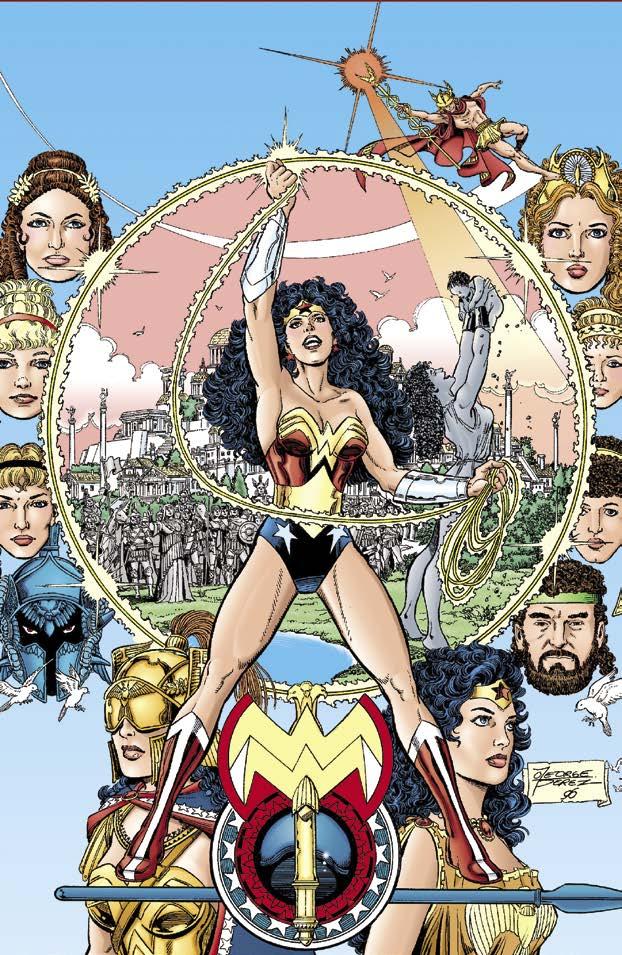
George Pérez Tribute Issue • BACK ISSUE • 69
TM & © DC Comics.
Pitching In with Pérez:
MINDY NEWELL

and
#46 (1990)
interview conducted by Steven Wilber
In 1990, a poignant tale was published in DC Comics’ Wonder Woman. By this stage in the series, writer George Pérez was joined by fellow writer Mindy Newell, who jumped aboard with issue #36. Together, Pérez and Newell reintroduced Eris, the Goddess of Discord, and the first envoy from the outside world to Themyscira, home of the Amazons. Princess Diana’s adopted family in Boston, Julia and Vanessa Kapatelis, had already visited the isle of paradise, but that didn’t mean they would be unaffected during Newell’s tenure on the series. With issue #46 (Sept. 1990), Vanessa’s best friend, Lucy, killed herself in a surprise twist. Here was a popular young woman from a well-to-do family who decided on her own that she had nothing left to live for. Lucy’s death would deeply affect Vanessa, Julia, and Diana. While a tale of tragedy, Wonder Woman #46 was written in a way that captured innocence and love, trademarks of the series that still speak to fans today. BACK ISSUE had the good fortune of speaking with Mindy Newell about this unforgettable story, Wonder Woman #46’s “Chalk Drawings.”
– Steven Wilber
STEVEN WILBER: Mindy, you were involved with writing Wonder Woman in the mid-’80s before your initial run was cut short because of continuity changes occurring in Crisis on Infinite Earths . You returned to the Amazing Amazon in the follow-up Wonder Woman series written by George Pérez. Can you tell us how your return to the world of Princess Diana came about?
MINDY NEWELL: All I really have is a memory of being in Karen’s [Karen Berger, Wonder Woman editor] office and of her asking me if I would like to dialogue Wonder Woman over George’s scripts. She probably also went on to tell me that George needed to step back for a while as he was overloaded with work, that they had discussed it, and together had decided to ask me to come on board.
Then again, memory is a funny thing, and maybe she called me at home.
Of course, I was surprised, flattered, and knocked off my feet, but, knowing myself pretty well, I probably said something like: “HOLY SH*T!”
And then I remembered to say yes.
WILBER: This was a slightly different Amazon Princess than who you had worked with. Was it difficult to get acclimated to a new and improved Wonder Woman?
NEWELL: Are you kidding? I loved George’s take on her!
Seriously, so much of what George did on the book synced with my ideas of Diana—the stranger in a strange land (with Julia Kapetelis as her guide and mentor, a sort of “Oracle of Delphi”), the emphasis on Diana’s Greek and mythological heritage, and her maturation as a woman and a superhero.
And I loved that Julia had a daughter, Vanessa, on the cusp of child transitioning to woman, experiencing all the anxieties and joyfulness of that transition— eager to become “an adult,” but not quite ready to leave behind the safety net of childhood. Vanessa was a parallel of sorts to Diana, who was also figuring out her path through man’s world.
WILBER: Lucy Spears was a minor character introduced prior to your arrival to the Wonder Woman book. Did George always intend for her demise? Can you recall the conversation you had that plotted out issue #46?
A Tale of Tragedy
Pérez’s cover to Wonder Woman #46 (Sept. 1990), which features the heartrending study of teen suicide, “Chalk Drawings.”
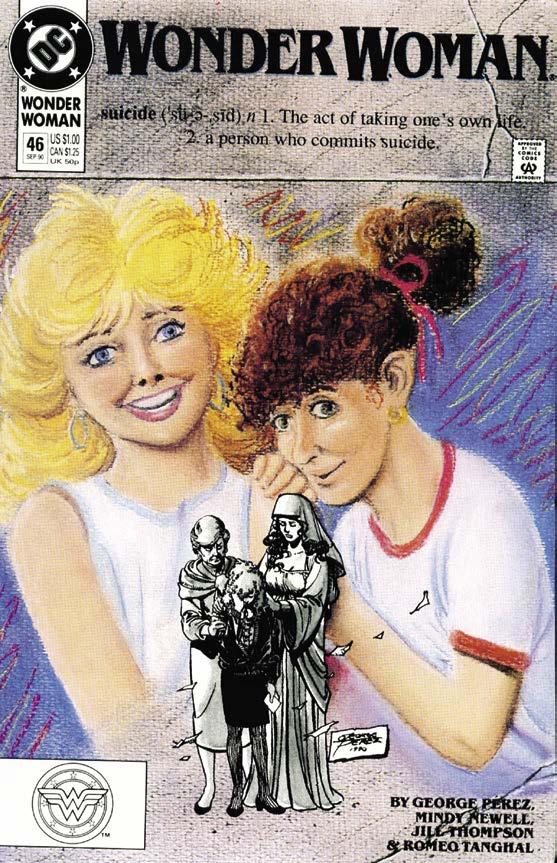
TM & © DC Comics. George Pérez Tribute Issue • BACK ISSUE • 77
mindy newell
Solemn Gathering (left) The Wonder Woman cast gathers to say farewell. Detail from page 2 of Wonder Woman #46. (right) Detail from page 11, showing Vanessa’s reaction to the suicide of her friend.
NEWELL: I think he did. Sadly, I never got the chance to discuss it directly with George, so I can’t comment on that.
I do remember telling him and Karen that I really, really loved that the story focused on the aftermath of suicide on family, friends, and peers, the shock, the anger, the desolation, and just trying to understand What the hell happened?
I’m really trying to remember honestly and correctly… was I the one who came up with the idea that we, the reader, would never really know why Lucy killed herself?
I think I was.
WILBER: Wonder Woman had become a comic book that didn’t shy away from real-world issues, but was there any trepidation about writing a story focused on teen suicide?

NEWELL: No. Not one bit. Except to say that we all—George, Karen, me—wanted to do it right, so if that’s what you wanted to call “trepidation,” so be it. (I hate to use this word in connection to writing about suicide, but I think the word for what we all felt was excited.)
You see, Lucy was portrayed as the “girl who had everything”—smart and pretty and popular, rich— and frankly, something of a “Heathers” to Vanessa, who idolized her and wanted to be her, to the point of following Lucy’s lead, to the detriment of Vanessa’s other friend, Eileen.
And it was Eileen who came closest to understanding what drove Lucy to suicide:
Eileen : Lucy was messed up, Ness. Stop blaming yourself.
Vanessa: SHE WAS NOT!!!!!
BACK ISSUE #147
ANNIVERSARY
Eileen: She was. She was lonely. She was miserable. She was depressed.
Vanessa: HOW DO YOU KNOW?
Eileen: ’Cause.
(84-page FULL-COLOR magazine) $10.95 (Digital Edition) $4.99
Eileen: I’ve been there. And once you’ve been there, you don’t forget it. And you get so you can see it in other people.
https://twomorrows.com/index.php?main_page=product_info&cPath=98_54&products_id=1757
Eileen: I saw it in Lucy, Ness.
That was me, talking through Eileen.
WILBER: Can you recall readers’ reactions after issue #46 was published?
NEWELL: Remember that “Chalk Drawings” was written pre-Internet, back when comics still had letter columns, so, yeah, we got tons of letters.
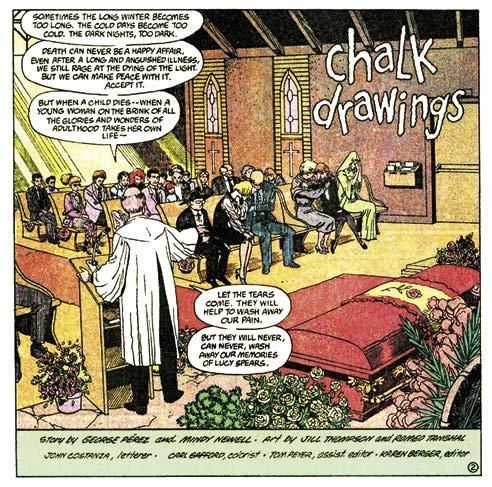
Sadly, all too many of them were from readers who had been touched by suicide and were deeply personal.
All of them were appreciative and thankful that we had published this story.
WILBER: In the Further Adventures of Wonder Woman anthology published by Bantam Books (1993), you had a chance to follow up the story when Diana discovers an abandoned baby. She and the Kapatelis Family find themselves in a race to discover the fate of the baby’s mother, and in the meantime, raise the baby. Straightaway, Julia fears for her daughter’s emotional state after Vanessa requests to name the baby “Lucy.” Where did you get the idea to tie these two stories together?

NEWELL: It just felt pretty natural and real, connecting the baby, Vanessa, Julia, and Diana together through the memory of Lucy.
You know, no one forgets. No one really gets past the pain. You just learn to live with it, or die a million little deaths every day for the rest of your life.
WILBER: Any final thoughts on your time writing “Chalk Drawings” or working with George Pérez on Wonder Woman?
NEWELL: As I told Karen shortly after George’s death: One day he said to me: “Single mothers are the superheroes. You are a superhero.”
Oh, George. I will never, ever forget working with you. And never, ever forget how blessed I was to do so.
And with you, Karen.
STEVEN WILBER is a storyteller on canvas and educator in the classroom based in Boston, inspired by his growing 30-plus-year collection of comic books.

78 • BACK ISSUE • George Pérez Tribute Issue
TM & © DC Comics.
IF YOU ENJOYED THIS PREVIEW, CLICK THE LINK TO ORDER THIS ISSUE IN PRINT OR DIGITAL FORMAT!
Great Hera, it’s the 20th
OF BACK ISSUE, featuring a tribute to the late, great GEORGE PÉREZ! Wonder Woman: The George Pérez Years, Pérez’s 20 Greatest Hits of the Bronze Age, Pérez’s fanzine days, a Pérez remembrance by MARV WOLFMAN, a Wonder Woman interview with MINDY NEWELL, and more! With a stunning Wonder Woman cover by (who else?) GEORGE PÉREZ!





























